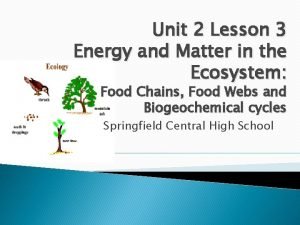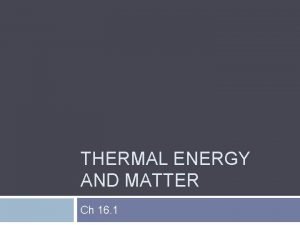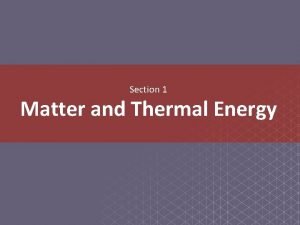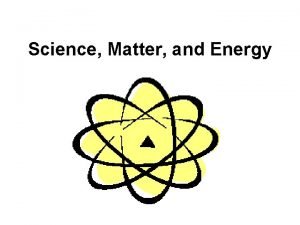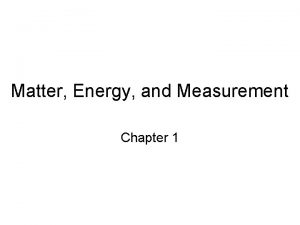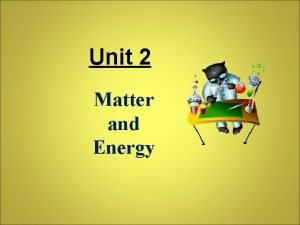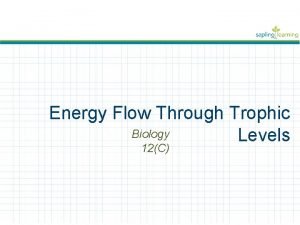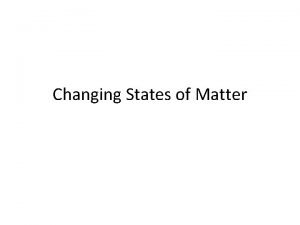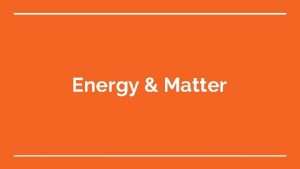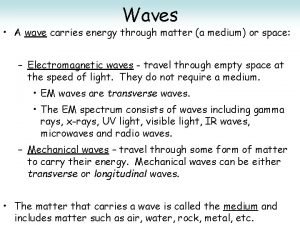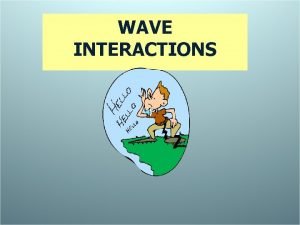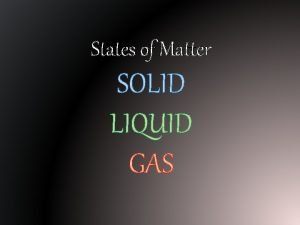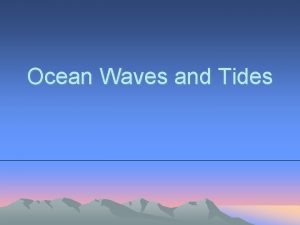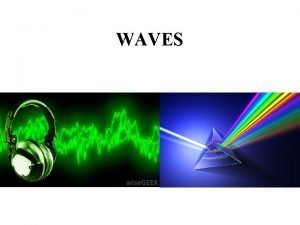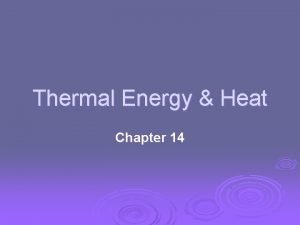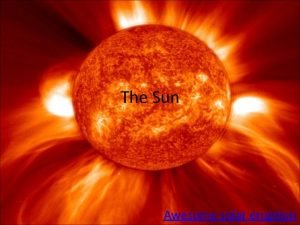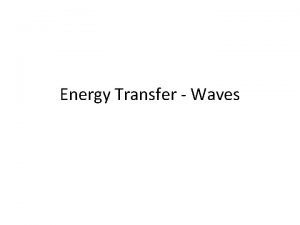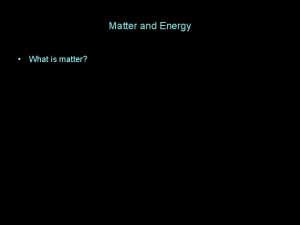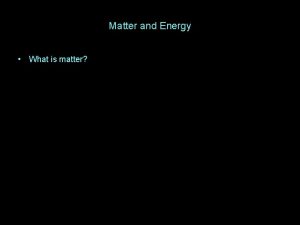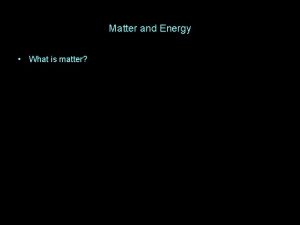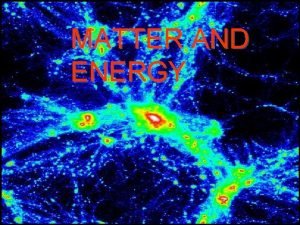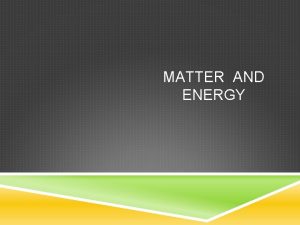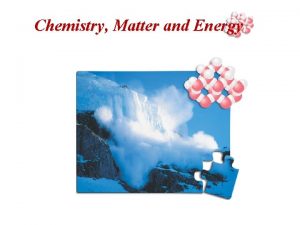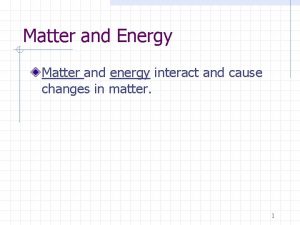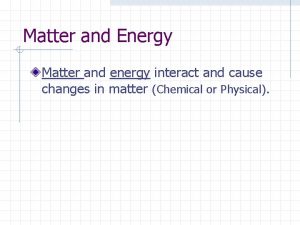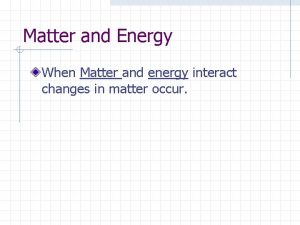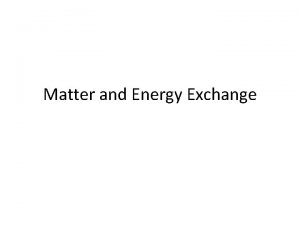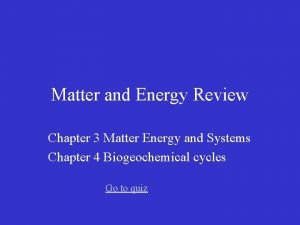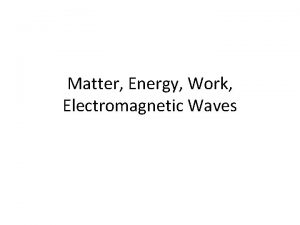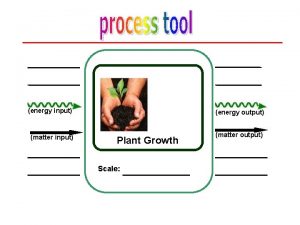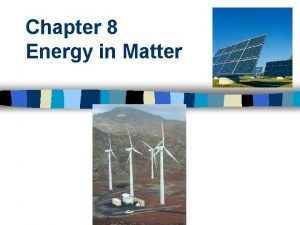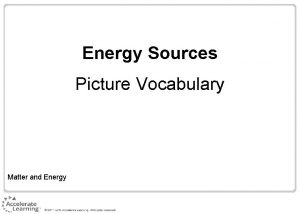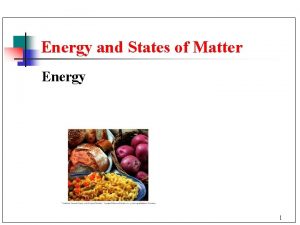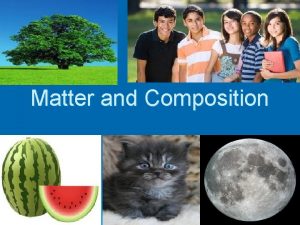Matter and Energy Matter and Energy n Matter




































- Slides: 36

Matter and Energy

Matter and Energy n Matter: Forms, Structure, and Quality – Elements – Compounds

Matter and Energy n Matter: Forms, Structure, and Quality – The structure of elements and compounds n Atom - the basic building block of all chemical elements

Matter and Energy n Matter: Forms, Structure, and Quality – The structure of elements and compounds n Molecule - a combination of two or more atoms of the same or different elements held together by chemical bonds

Matter and Energy n Matter: Forms, Structure, and Quality – The structure of elements and compounds n Ion - an atom or a group of atoms with one or more positive (+) or negative (-) electrical charges – Na+1

Matter and Energy n Matter: Forms, Structure, and Quality – The structure of atoms and molecules n Subatomic particles – Protons (+) – Neutrons (o) – Electrons (-)

Matter and Energy n Matter: Forms, Structure, and Quality – The structure of atoms and molecules n Atomic Number (AN) - number of protons in the nucleus of a chemical element – Hydrogen: AN = 1 – Carbon: AN = 6 – Uranium: AN = 92

Matter and Energy n Matter: Forms, Structure, and Quality – The structure of atoms and molecules n Mass Number (MN) - the total number of neutrons and protons in the nucleus of an atom – Hydrogen: MN = 1 proton + 0 neutron = 1 – Uranium: MN = 92 protons + 143 neutrons = 235

Matter and Energy n Matter: Forms, Structure, and Quality – The structure of atoms and molecules # protons = # electrons n No net electrical charge n

Matter and Energy n Matter: Forms, Structure, and Quality – The structure of atoms and molecules n Isotope - two or more forms of a chemical element that have the same number of protons but different numbers of neutrons in their nuclei

Matter and Energy n Matter: Forms, Structure, and Quality – The structure of atoms and molecules n Ion - an atom or group of atoms with one or more positive or negative electrical charges

Matter and Energy n Matter: Forms, Structure, and Quality – The structure of atoms and molecules n Ions – Sodium (Na) n 11 protons + 11 electrons no net charge n Loses 1 electron n 11 electrons + 10 protons net + 1 charge (Na+1)

Matter and Energy n Matter: Forms, Structure, and Quality – The structure of atoms and molecules n Types of chemical bonds – Ionic – Covalent – Hydrogen

Matter and Energy n Matter: Forms, Structure, and Quality – The structure of atoms and molecules n Types of chemical bonds – Ionic Bond - bond formed by attraction between oppositely charged ions

Matter and Energy n Matter: Forms, Structure, and Quality – The structure of atoms and molecules n Types of chemical bonds – Covalent Bond - bond formed by the sharing of electrons between atoms

Matter and Energy n Matter: Forms, Structure, and Quality – The structure of atoms and molecules n Types of chemical bonds – Hydrogen Bond - occurs between molecules in which hydrogen is bonded to nitrogen, oxygen, or fluorine

Matter and Energy n Matter: Forms, Structure, and Quality – Types of Compounds Organic n Inorganic n

Matter and Energy n Matter: Forms, Structure, and Quality – Types of Compounds n Organic Compounds - compounds that contain carbon atoms that are bonded to other carbon atoms and/or with atoms of H, O, N, S, Cl, F

Matter and Energy n Matter: Forms, Structure, and Quality – Types of Compounds n Examples of Organic Compounds – Hydrocarbons n Methane gas (CH 4) – Chlorinated hydrocarbons n DDT (C 14 H 9 Cl 5)

Matter and Energy n Matter: Forms, Structure, and Quality – Types of Compounds n Examples of Organic Compounds – Chloroflurocarbons n Freon-12 (CCl 2 F 2) – Simple carbohydrates n Glucose (C 6 H 12 O 6)

Matter and Energy n Matter: Forms, Structure, and Quality – Types of Compounds n Examples of Organic Compounds – Complex carbohydrates – Proteins – Nucleic Acids

Matter and Energy n Matter: Forms, Structure, and Quality – Types of Compounds n Examples of Inorganic Compounds – Salt (Na. Cl) – Water(H 2 O) – Carbon dioxide (CO 2) – Hydrochloric acid (HCl)

Matter and Energy n Matter: Forms, Structure, and Quality – Matter Quality n Matter Quality - a measure of how useful a matter resource is based on its availability and concentration

Matter and Energy n Energy: Forms and Quality – Classification of Energy Kinetic n Potential n Electromagnetic radiation n

Matter and Energy n Energy: Forms and Quality – Forms of Kinetic Energy n Heat - total kinetic energy of all moving atoms, ions, and molecules within a given substance – Temperature - the average speed of motion of the atoms, ions, and molecules in a sample of matter at a given moment

Matter and Energy n Energy: Forms and Quality – Energy Quality n Energy Quality - the measure of an energy source’s ability to do useful work

Matter and Energy n Physical, Chemical, and Nuclear Changes in Matter – Physical Change - a change that involves no change in the chemical composition of the material

Matter and Energy n Physical, Chemical, and Nuclear Changes in Matter – Chemical Change - a change that involves changes in the chemical composition of the elements or compounds involved

Matter and Energy n Physical, Chemical, and Nuclear Changes in Matter – Nuclear Changes - a process in which nuclei of certain isotopes spontaneously change into one or more different isotopes

Matter and Energy n Physical, Chemical, and Nuclear Changes in Matter – Nuclear Changes n Types – Natural radioactive decay – Nuclear fission – Nuclear fusion

Matter and Energy n Physical, Chemical, and Nuclear Changes in Matter – Nuclear Changes n Natural radioactive decay - process in which unstable isotopes spontaneously emit high-energy, fast moving particles

Matter and Energy n Physical, Chemical, and Nuclear Changes in Matter – Nuclear Changes n Nuclear Fission - nuclear change in which the unstable nuclei isotopes are split into lighter nuclei when hit by a neutron

Matter and Energy n Physical, Chemical, and Nuclear Changes in Matter – Nuclear Changes n Nuclear Fusion - nuclear change in which two isotopes of light elements (H) are forced together at high temperatures until they fuse to form a heavier nucleus

Matter and Energy n The Law of Conservation of Matter – The Law of Conservation of Matter -in any physical or chemical change, matter is neither created nor destroyed, but merely changed from one form to another

Matter and Energy n The Laws of Energy – First Law of Energy - in all physical and chemical changes, energy is neither created nor destroyed, but it may be converted to one form or another

Matter and Energy n The Laws of Energy – Second Law of Energy - in any conversion of energy from one form to another, some of the high quality useful energy is converted to lowerquality, more dispersed, less useful energy
 Energy naturally flows from warmer matter to cooler matter.
Energy naturally flows from warmer matter to cooler matter. Energy energy transfer and general energy analysis
Energy energy transfer and general energy analysis Energy energy transfer and general energy analysis
Energy energy transfer and general energy analysis Meysam golmohammadi
Meysam golmohammadi Gyrus and sulcus function
Gyrus and sulcus function Gray matter and white matter
Gray matter and white matter What is grey matter
What is grey matter Section 1 composition of matter
Section 1 composition of matter Section 1 composition of matter
Section 1 composition of matter Chapter 2 matter section 1 classifying matter answer key
Chapter 2 matter section 1 classifying matter answer key Section 1 composition of matter chapter 15 answer key
Section 1 composition of matter chapter 15 answer key Phosphorus cycle
Phosphorus cycle Which reverses the normal flow of thermal energy
Which reverses the normal flow of thermal energy Section 1 matter and thermal energy
Section 1 matter and thermal energy Science matter
Science matter Matter energy and measurement
Matter energy and measurement Dark matter and dark energy presentation
Dark matter and dark energy presentation Unit 2 matter and energy
Unit 2 matter and energy Teophic levels
Teophic levels Lesson 1 thermal energy and the behavior of matter
Lesson 1 thermal energy and the behavior of matter Phase change concept map
Phase change concept map States of matter foldable
States of matter foldable Mechanical waves examples
Mechanical waves examples How do matter and energy interact when waves are generated
How do matter and energy interact when waves are generated Labeled energy pyramid
Labeled energy pyramid What waves do not require a medium
What waves do not require a medium Waves transfer energy without transferring matter
Waves transfer energy without transferring matter Which state of matter has the most thermal energy
Which state of matter has the most thermal energy Rhythmic movement that carries energy through matter
Rhythmic movement that carries energy through matter Flow of energy vs flow of matter
Flow of energy vs flow of matter A repeating disturbance that transfers energy
A repeating disturbance that transfers energy Heat vs thermal energy vs temperature
Heat vs thermal energy vs temperature Uses of heat
Uses of heat Internal energy of matter
Internal energy of matter A loop of relatively cool incandescent gas
A loop of relatively cool incandescent gas A wave is a disturbance that transmits
A wave is a disturbance that transmits Types of waves
Types of waves











